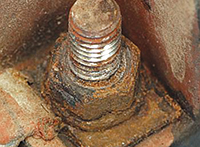
When a claim is denied, generally it’s because the product doesn’t exhibit signs of failure or the failure is not under warranty. External factors that are not covered by warranty include improper installation, incorrect application, control circuit problems or operator issues such as extended overcranking.
Common Issues with Alternators and Starters
 |
High Resist
At times, you may submit a warranty claim only to be surprised that it is denied.ance
Corrosion or rust build-up on electrical connections will cause a high resistance connection, creating a high voltage drop. |
 |
Loose Connections
Inspect for evidence of loose electrical connections: broken, stripped and/or cross-threaded terminals. Arcing and burning are signs of a loose electrical connection. Arcing and burning present on washers, nut clamping surfaces and terminal threads are signs of a loose connection. A loose connection may melt the insulators and loosen the stack-up, causing the connection to overheat and/or short to ground. |
 |
Loose Mounting Lugs
Inspect for signs of loose mounting and vibration damage, such as elongated mounting holes. |
 |
Customer Extra Parts
When a nut, bolt or any other foreign object drops into the starter or alternator during installation, it must be removed before the battery is connected or the unit will fail. |
Common Issues with Alternators
 |
Loose Belt or Tensioner
When a pulley has heat discoloration (distinctly blue) and the alternator rotates freely, look for a loose belt or defective tensioners, which should be replaced as needed. |
 |
Environmental
Inspect for unusual environmental conditions, such as corrosion, dirt, oil or other contamination. If the bridge or access holes are plugged, then the alternator is not cooling properly, which could result in overheating and premature failure. |
 |
Improper Installation
Hand tighten mounting bolts before applying torque. This helps eliminate binding and unwanted stress on the housing, which can break mounting flanges. Excessive torque also can cause this failure mode. |
 |
Loose Pulley
Inspect for evidence of a loose pulley, wear on the fan hub clamping surface or bearing race. Radial wear on a rotor shaft also may be visible. |
Common Issues with Starters
 |
Over Crank
The cranking motor is designed for intermittent duty with a maximum of 30 seconds continuous cranking. Over crank can be caused by cranking with low system voltage or engine control circuit problems. This may allow the engine to crank but not start. |
 |
Solder Reflow
Solenoid solder connection reflow occurs when prolonged power is applied to the solenoid switch terminal in an attempt to start the engine. This failure can be caused by low system voltage and/or pinionto- ring gear tooth abutment. |
 |
Milled Pinion
A severely milled or damaged drive pinion is evidence of engagement into a rotating ring gear. This condition can be caused by a control circuit problem external to the motor.
|
